
Selective fire is the capability of a weapon to be adjusted to fire in semi-automatic, fully automatic, and/or burst mode. The modes are chosen by means of a selector switch, which varies depending on the weapon's design. Some selective-fire weapons have burst fire mechanisms to limit the maximum number of shots fired automatically in this mode. The most common limits are two or three rounds per trigger pull. Fully automatic fire refers to the ability for a weapon to fire continuously until either the feeding mechanism is emptied or the trigger is released. Semi-automatic refers to the ability to fire one round per trigger pull.
Firefighting jargon includes a diverse lexicon of both common and idiosyncratic terms. One problem that exists in trying to create a list such as this is that much of the terminology used by a particular department is specifically defined in their particular standing operating procedures, such that two departments may have completely different terms for the same thing. For example, depending on whom one asks, a safety team may be referred to as a standby, a RIT or RIG or RIC, or a FAST. Furthermore, a department may change a definition within its SOP, such that one year it may be RIT, and the next RIG or RIC.
This is a glossary of firefighting equipment.

A heat sealer is a machine used to seal products, packaging, and other thermoplastic materials using heat. This can be with uniform thermoplastic monolayers or with materials having several layers, at least one being thermoplastic. Heat sealing can join two similar materials together or can join dissimilar materials, one of which has a thermoplastic layer.

The National Weather Center (NWC), on the campus of the University of Oklahoma, is a confederation of federal, state, and academic organizations that work together to better understand events that take place in Earth's atmosphere over a wide range of time and space scales. The NWC partners give equal attention to applying that understanding to the development of improved observation, analysis, assimilation, display, and prediction systems. The National Weather Center also has expertise in local and regional climate, numerical modeling, hydrology, and weather radar. Members of the NWC work with a wide range of federal, state, and local government agencies to help reduce loss of life and property to hazardous weather, ensure wise use of water resources, and enhance agricultural production. They also work with private sector partners to develop new applications of weather and regional climate information that provide competitive advantage in the marketplace.

Gaseous fire suppression, also called clean agent fire suppression, is a term to describe the use of inert gases and chemical agents to extinguish a fire. These agents are governed by the National Fire Protection Association (NFPA) Standard for Clean Agent Fire Extinguishing Systems – NFPA 2001 in the US, with different standards and regulations elsewhere. The system typically consists of the agent, agent storage containers, agent release valves, fire detectors, fire detection system, agent delivery piping, and agent dispersion nozzles.
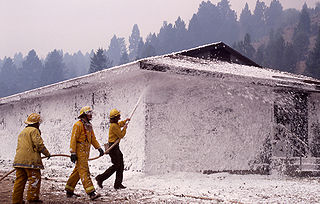
Firefighting foam is a foam used for fire suppression. Its role is to cool the fire and to coat the fuel, preventing its contact with oxygen, resulting in suppression of the combustion. Fire-fighting foam was invented by the Russian engineer and chemist Aleksandr Loran in 1902.
Active fire protection (AFP) is an integral part of fire protection. AFP is characterized by items and/or systems, which require a certain amount of motion and response in order to work, contrary to passive fire protection.
A fire class is a system of categorizing fire with regard to the type of material and fuel for combustion. Class letters are often assigned to the different types of fire, but these differ between territories. There are separate standards for the United States, Europe, and Australia. This is used to determine the type of extinguishing agent that can be used for that fire class.

A compressed air foam system (CAFS) is used in firefighting to deliver fire retardant foam for the purpose of extinguishing a fire or protecting unburned areas.
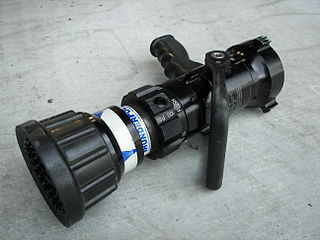
A fog nozzle is a firefighting hose spray nozzle that breaks its stream into small droplets. By doing so, its stream achieves a greater surface area, and thus a greater rate of heat absorption, which, when compared to that of a smoothbore nozzle, speeds its transformation into the steam that smothers the fire by displacing its oxygen. Specially designed fog nozzles have been certified by Underwriters Laboratories (UL) for use on Class B & C hazards.

In automatic firearms, burst mode or burst-fire is a firing mode enabling the shooter to fire a predetermined number of rounds, usually two or three rounds on hand held weapons and 50-100+ on anti-aircraft weapons and autocannons, with a single pull of the trigger. This firing mode is commonly used in submachine guns and assault rifles. Other types of firearms, such as machine pistols, e.g., the Heckler & Koch VP70 and Beretta 93R also have a burst mode.

A fire extinguisher is an active fire protection device used to extinguish or control small fires, often in emergency situations. It is not intended for use on an out-of-control fire, such as one which has reached the ceiling, endangers the user, or otherwise requires the equipment, personnel, resources and/or expertise of a fire brigade. Typically, a fire extinguisher consists of a hand-held cylindrical pressure vessel containing an agent that can be discharged to extinguish a fire. Fire extinguishers manufactured with non-cylindrical pressure vessels also exist but are less common.
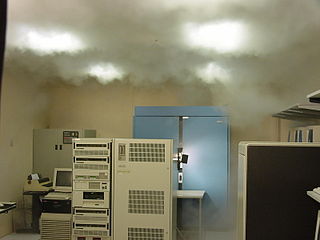
Automatic fire suppression systems control and extinguish fires without human intervention. Examples of automatic systems include fire sprinkler system, gaseous fire suppression, and condensed aerosol fire suppression. When fires are extinguished in the early stages loss of life is minimal since 93% of all fire-related deaths occur once the fire has progressed beyond the early stages.
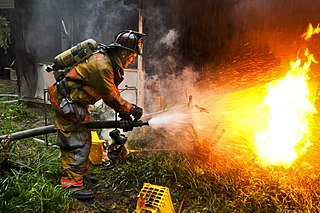
Firewater refers to water that has been used in firefighting and requires disposal. In many cases, it is a highly polluting material and requires special care in its disposal.
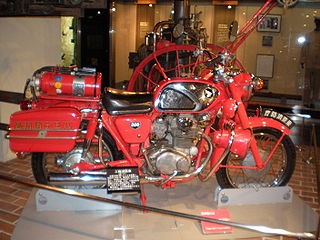
A fire bike is a motorcycle used by a fire department. Several countries around the world use fire bikes, often to beat traffic congestion, and the equipment carried ranges from simple extinguishers to jet guns with hose rigs. Firefighters also use fire bikes to offer medical treatment. In the United Kingdom, fire bikes are used by some fire services in road safety awareness campaigns.

Condensed aerosol fire suppression is a particle-based form of fire extinction. It is similar to dry chemical fire extinction).
Vladimir Zakhmatov is an independent expert at the international level of explosions and fire-fighting, well-known scientist in the field of physics of combustion and explosion, developer of modern impulse fire-extinguishing devices and systems, Doctor of Engineering Sciences, Professor, active member of the International Academy of Ecology and Safety , the New York Academy of Sciences (USA), Ukrainian Academy of Life Safety (Ukraine).

The Abram S. Hewitt was a coal-powered fireboat operated by the Fire Department of New York City from 1903 to 1958. She was the department's last coal-powered vessel and had a pumping capacity of 7,000 gallons per minute.













